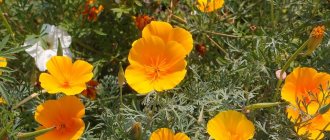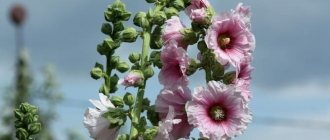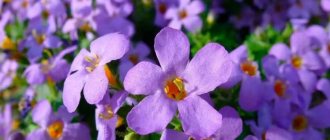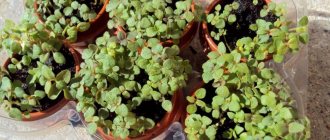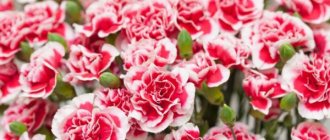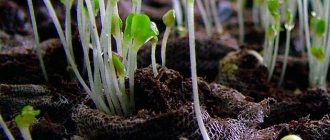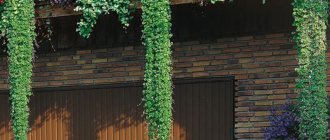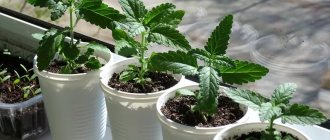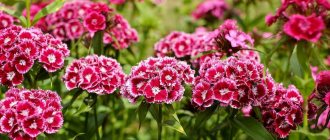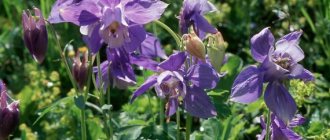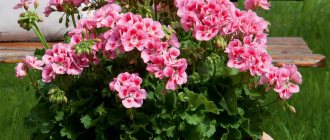Description and features of alyssum
Alyssum (Alyssum) has dense, semi-lignified shoots, they are straight, ascending or creeping. The flower forms a dense subshrub from 10 cm to a meter in height and up to 1.5 in width. The leaves are thick, petiolate, oblong, oval, covered with silvery down. Reaches 15-40 cm, the buds are formed from four petals arranged crosswise and combined into inflorescences.
The flowers are presented in small clusters of snow-white, golden, pink, lilac, and yellow colors. They bloom in May, bloom until late autumn, excellent honey plants. The honey aroma of certain varieties of alyssum spreads over several meters.
The fruit is a flat pod with seeds that remain viable for three years. The rhizome is superficial with adventitious roots.
Forming a fluffy carpet, alyssum is used in the landscape design of parks, squares, for the design of flower beds, rock gardens, and ridges. They are also used to decorate hanging flowerpots, pots, and boxes.
Alyssum contains alkaloids, organic acids, flavonoids and has medicinal properties. It is used as a decoction for colds, an infusion for facial care, and dried parts in aromatherapy.
Types and varieties of alyssum
Types and varieties vary in height and color palette.
| View | Description | Varieties | Flowers |
| Rocky | 28-30 cm high. Leaves do not fall even in winter. The flowers are paniculate, bloom in April-May, and fade early. | Citrinum | Lemon yellow. |
| Plenum | Terry, golden yellow. | ||
| Dudley Neville | Yellow-brown. | ||
| Gold painting | They bloom after two years, golden yellow. | ||
| Aphrodite | Purple. | ||
| Compactnum | Small, fragrant, yellow. | ||
| Nautical | In the middle zone it is distributed as an annual, up to 25 cm high. The stems form compact rosettes. Blooms from May until frost. | Schneeshturm | Large, white. |
| Purple Haze | Purple. | ||
| Esther Bonnet Deep Rose | Small, bright, lilac-pink. | ||
| Violet Konigin | Purple. | ||
| Apricot | Pink-salmon. | ||
| Ampelny | Popular for pots, with highly branching and long stems. The inflorescences create a huge ball. Blooms from July to October. | Snow | White, blooming like a carpet. |
| Snow Princess | Small, snow-white, very fragrant. | ||
| Gmelina (mountain) | The branches are creeping and ascending. The leaves are pubescent. The raceme-shaped inflorescences bloom in May and August. | Honey dessert | Small, yellow. |
| golden wave | Bright yellow. |
Short description
In spring, rocky garden beds will be pleased with golden-yellow flowers; from summer to autumn, we will be delighted by sea alyssum with white, pink or purple flowers. The flowers are small but numerous, located on one stem, collected in so-called clusters. Shoots with flowers reach a length of 30 cm, growing from a rosette of oblong leaves of grayish-green color.
Climatic conditions for alyssum
Annuals are characterized by long flowering, and perennials are resistant to low temperatures. The climate for the unpretentious alyssum is both warm and harsh.
There are species that adapt well to the northern regions; alyssum seedlings are planted there. In warm climates, the seeds are sown directly into the ground and the plant delights with its blooming appearance more than once a season.
Methods for planting alissum
Alyssum is planted with seedlings and seeds. The seedlings are pre-prepared in a greenhouse, with the onset of sunny and warm weather they are placed in a flower bed; the second method is to immediately sow the seeds.
Growing alyssum from seeds
When grown from seeds, alyssum will bloom in 1.5 months.
Another option is to sow them in November. Thus, the process of stratification will take place and the spring seedlings will be healthier. But in cold climates they can die.
The soil for seeds is dug up, cleared of weeds, loosened, and watered if necessary. You can plant them in a permanent place or first in a separate bed. Place the seed material in the grooves. Moisten and cover with film. Weed regularly. Shoots appear after a week at a temperature of +16 °C. They are thinned out to a distance of more than 10 cm and fertilized with mineral mixtures.
In November, seeds are still sown before winter, in 1-2 cm grooves. Sand is poured, dry seed is placed, and sprinkled on top. The next season shoots appear. If it's cold, they are covered with film. Then, when the seedlings grow, they place them in the selected area.
Growing alyssum with seedlings
In cold areas, seedlings are prepared as early as mid-March. Seeds are sown in containers, soil is purchased in a specialized store or pots with peat. Choose dishes with drainage holes. They are scattered and left in the light. Cover with film and ventilate regularly. Create bright lighting, temperature +10...+15 °C, moderate humidity, water. When the first true leaf appears, it is fed. They dive when 2-3 leaves are formed. For hardening, the seedlings are regularly taken out into the air for a few minutes.
When and how to collect seeds
Alyssum seeds are usually collected in September or October. A sunny and windless day is suitable for this. The seeds are very small, so they work with them according to this scheme:
- A thick blanket is laid out near the flowerbed.
- They pull out an alyssum bush and rub each inflorescence with their hands over the litter.
- Remove large debris from the fallen seeds.
- Pour the planting material into a bag made of thick natural fabric.
- Store seeds in a dry place with good ventilation, but without drafts.
Planting alyssum in open ground
Planting and care in open ground is distinguished by the choice of location, timely watering, and fertilizing. Seedlings or seeds are planted in the spring, from April to June, and the area should be sunny, without stagnant moisture, the soil should be neutral, slightly alkaline.
The flower loves to grow next to a rocky path or decorative tiles. Too nutritious soil produces dense greenery and few flowers.
What time to plant alyssum
The month of planting is chosen depending on the region, usually in May-June. Plant a flower in a flowerbed only when the frosts have passed and the soil has warmed up.
Landing Features
When growing in open ground, take into account the type of flower in order to dig the appropriate hole for the development of the root system. Sand is added to dense soil. The distance between plants is maintained at 25-40 cm.
Application in landscape design
Alyssum is an excellent proposal for climbing frames, borders and perennial flower beds.
Alyssum on rocks, photo
They are also suitable for growing in containers on the terrace, balcony, especially the sea view. Sea varieties look great in flower beds. Since they are low, they also look very good in pots and hanging baskets. You can successfully grow them on balconies and terraces, especially on the south side, not shaded by trees or buildings. When planting on balconies or in large pots, place them near the edge of the container to allow the stems to hang freely.
Rock borage combines well with other spring perennials, such as phlox.
Alyssiums are very beautiful flowers - both annual marine species and perennial rocky ones. They look different, but bloom beautifully and are not demanding. These are small, purely ornamental plants, including many species, completely different from each other. Alyssum is relatively unpretentious to conditions and soils, so it often becomes an inhabitant of flower beds, rock gardens, and decoration of balconies and terraces.
Alyssum care
Water the flower abundantly, especially in hot weather, but it does not like stagnant moisture. When the soil dries out by 2-3 cm, then this should be done. Remove weeds and regularly loosen the soil. They also use an automatic watering system.
The perennial is fertilized with a solution of urea and Agricola (1 tbsp per 10 liters). Before flowering, it needs complex mixtures, twice a season is enough. Annuals prefer frequent feeding up to four times. They are applied at the root in the morning.
Pruning alyssum
In the spring, old peduncles, dried leaves, and weak, diseased stems are cut off from perennial specimens. After summer flowering, shoots are cut to 50-80 mm, forming a beautiful and compact bush.
Alyssum after flowering
When the alyssum has finished blooming, it is prepared for wintering. The annual plant is removed, and the perennial plant is cut by 2/3 and the soil around is loosened.
Collecting seeds
In September and early October, seeds are collected from the flower. For collection choose dry, windless weather. They usually spread a blanket under the bush and rub the inflorescences with their hands. The seed material is dried and stored in paper bags or fabric bags until the next season.
Wintering perennial
Before the onset of cold weather, pruning is not done. Alyssum may die if the temperature is -15 °C, so the flower is covered with dry leaves, mulch is placed under the bushes, and when snow appears, it is covered with it. This is how the plant survives the winter.
Rules for caring for and growing in the garden
Perennial alyssum, or alyssum, is unpretentious and can actively grow and bloom even with minimal care. To maintain health and abundant flowering, you should follow several simple procedures, which boil down to regular watering, shaping, and fertilizing.
Watering
The plant practically does not need watering and can bloom even in dry soil. Alyssum is actively watered only when the weather remains dry and warm, and there is no rainfall for a long time. To maintain humidity, it is recommended to regularly spray the flower garden, which is enough for the comfortable development of plants. It is impossible to allow both waterlogging and drying out of the substrate and the formation of a dry crust on the surface. You can determine the need for active watering by the condition of the leaves and flowers - they begin to turn yellow or white, and lose their elasticity.
Top dressing
During the summer, alyssum is fertilized twice. The first fertilizing should be carried out at the beginning of the active growing season to enhance the growth of green mass. For this purpose, urea or ammophoska is suitable at the rate of 10 g per 10 l; the composition should be watered on the soil and sprayed on the leaves. The second feeding should be carried out during the period of active flowering; it is advisable to use a complex mineral composition for root application as a fertilizer.
Loosening, mulching
Alyssum grows best in light soils with good aeration, so after each watering it is advisable to loosen the soil to a depth of 8 cm. It is advisable to carry out the procedure with a wooden stick so as not to damage the roots of the plant. At the same time, weeding is carried out.
Mulching is carried out only when planting seeds in open ground, as well as in the winter, to maintain the warmth of the surface layer of the earth. During the entire growing season, the procedure may not be carried out.
Pinching, pinching, pruning
Alyssum actively grows in width, so already at the end of the first year of life the plant looks sloppy. To maintain decorativeness, it is important to carry out shaping. The procedure is carried out twice per season - in the fall after flowering and in early spring. Last year's flower stalks need to be trimmed, as well as all dried and deformed leaves and shoots with signs of disease. In spring, it is important to pinch out all shoots by 5-8 cm, which will further enhance flowering next season.
Transfer
Alyssum is a perennial plant that can actively grow and bloom in one place for a long time. Replanting is required when growing a flower in a flower bed for more than 5-7 years, when signs of disease or a decrease in growth rate appear.
The procedure can be carried out in autumn or spring. To do this, you need to cut off all the shoots and stem, keeping no more than 5 cm in length. Then dig up the flower along with a lump of earth and transfer it to a new place. After transplantation, the plant needs to be watered abundantly, and after 14 days a complex mineral supplement should be applied.
Alyssum propagation
The flower is propagated by cuttings, dividing the bush, seeds, and it is also capable of self-sowing.
The first method is not very popular; cut cuttings of an adult flower are placed in a container of water. Then they are rooted in a container with soil.
When dividing a bush, it is dug up, divided into parts and planted at a distance of 30 cm.
The seed method was discussed above.
Diseases and pests of alyssum
The flower can be susceptible to fungal diseases, and it is also sometimes attacked by pests.
| Pest or disease | Manifestations on leaves | Remedies |
| Late blight (brown rot) | Many brown-gray spots. | They are treated with copper oxychloride and fungicides - Ordan, Tanox. |
| Viral mosaic | In mosaic spots, the shoots weaken. | Infected bushes are destroyed and the soil is changed. |
| Downy mildew (downy mildew) | Small red, purple or brown spots. | Treated with Oksikhom, Ordan, Bordeaux mixture. |
| Powdery mildew | White coating on all parts of the plant. | Spray with Topaz. |
| Cruciferous flea beetle | Black bugs with a green tint are gnawing. | Use Actellik, vinegar essence (1 tbsp and 10 liters of water). |
| Mealybug | White insects and plaque on the plant. | Treated with Fitoverm, Aktara. |
| White turnip | Sluggish, wilted shoots, pale green insects visible. | Entobacterin is used. |
| Cabbage moth | They dry out and growth stops. | Spray with Lepidocide. |
| Caterpillars | Destroy leaf blades and shoots. | Use a solution of tobacco with soap, chamomile, Kinmiks. |
